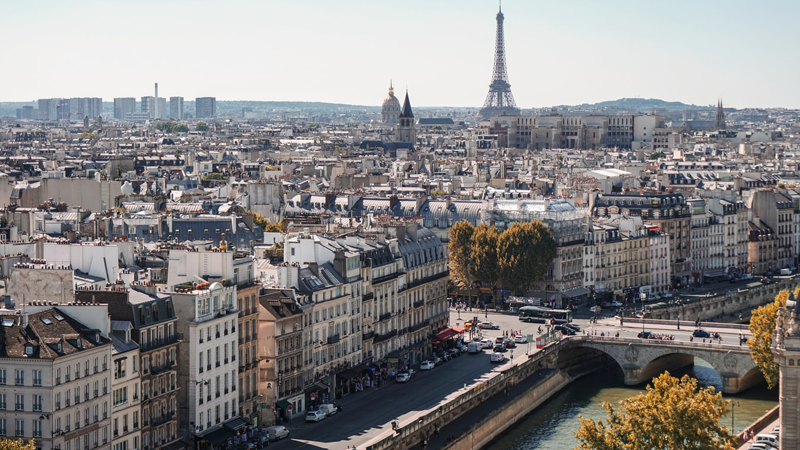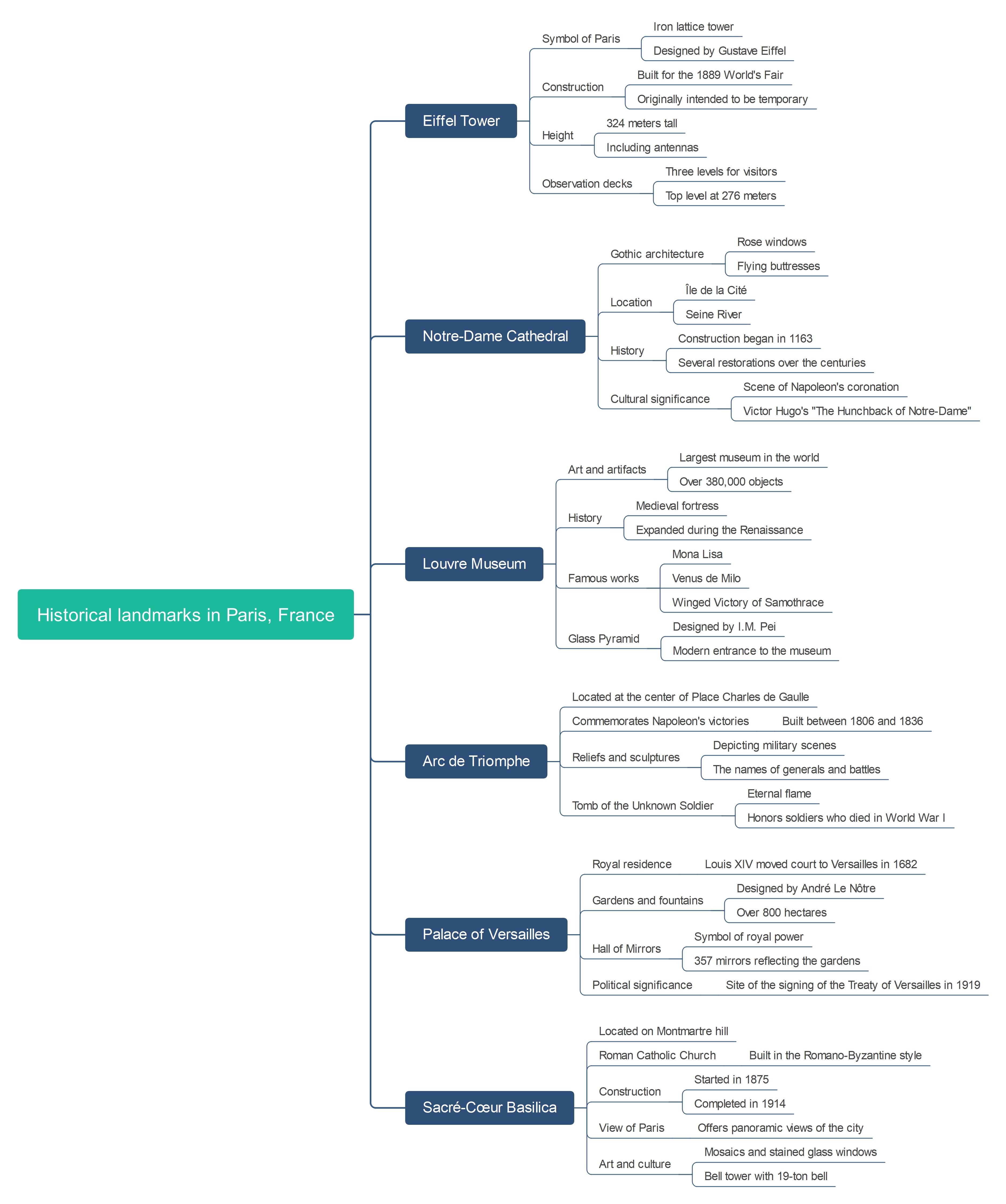Paris is one of the most famous cities in the world and is often called “the City of Light.” It is the capital of France and lies in the north-central part of the country, along the River Seine. The city is celebrated for its artistic heritage, architectural beauty, and cultural influence.
Paris’s long and eventful history is reflected in its magnificent monuments, churches, museums, and historic buildings, all of which illustrate its evolution from a small settlement to a global metropolis.
The origins of Paris date back to around 250 BCE, when it was first settled by a Celtic tribe known as the Parisii on an island in the Seine, now called Île de la Cité. The Romans later conquered the region and named it Lutetia, which eventually grew into medieval and modern Paris.
Over the centuries, the city became a center of learning, religion, and government, and played a major role in the French Revolution (1789–1799), the Napoleonic era, and the modern industrial and cultural expansion of France.
Today, Paris is renowned for its world-class art, cuisine, fashion, and architecture. The Eiffel Tower, built in 1889 for the World’s Fair, remains its most iconic landmark, while the Louvre Museum houses masterpieces such as Leonardo da Vinci’s Mona Lisa and the Venus de Milo. Other significant sites include Notre-Dame Cathedral, the Arc de Triomphe, and the Palace of Versailles, which lies just outside the city.
Paris is also the economic and political heart of France. It accounts for a large share of the country’s wealth and innovation, hosting the headquarters of many national and international corporations. The Île-de-France region, which includes Paris, produces nearly one-third of France’s GDP and is one of the most productive metropolitan areas in Europe.
The Paris economy is diverse and includes finance, luxury goods, publishing, technology, aerospace, and biotechnology, as well as a thriving tourism industry that attracts millions of visitors each year.
Paris continues to be a city where history and modernity coexist, offering a unique blend of cultural richness, artistic excellence, and economic vitality that makes it one of the most influential cities in the world.
In this article
Most Important Historical Events in the History of Paris

Throughout its long and eventful past, Paris has been the setting for many defining moments in French and world history. The following are some of the most significant events that shaped the identity of the city and the nation.
The Storming of the Bastille (14 July 1789)
In July 1789, growing unrest in Paris reached a breaking point due to food shortages, economic hardship, and high taxation under King Louis XVI. On 14 July 1789, angry crowds stormed the Bastille, a medieval fortress and political prison that had come to symbolize royal tyranny. The prison contained only seven inmates at the time, most of whom were not political prisoners, but the event became a powerful symbol of the people’s uprising against oppression.
The fall of the Bastille marked the beginning of the **French Revolution** and is remembered today as a turning point in the struggle for liberty and equality. Bastille Day, celebrated every 14 July, is now France’s national holiday, commemorating this landmark event.
The Execution of King Louis XVI (21 January 1793)
After the revolution began, King Louis XVI was tried by the National Convention, which was France’s first republican government. Found guilty of treason, he was sentenced to death. On 21 January 1793, he was executed by guillotine at the Place de la Révolution, a square now known as the Place de la Concorde.
The execution of the monarch marked the end of absolute monarchy in France and the consolidation of revolutionary ideals. It also triggered widespread political turmoil in Europe, leading to wars between revolutionary France and several neighboring monarchies.
The Coronation of Napoleon I (2 December 1804)
Napoleon Bonaparte, one of France’s most influential leaders, crowned himself Emperor of the French on 2 December 1804 in a grand ceremony at the Notre-Dame Cathedral in Paris. The event was attended by Pope Pius VII, but Napoleon famously placed the crown on his own head to emphasize that his authority came from his own achievements rather than from the Church.
This coronation symbolized the rise of a new political order, merging the legacies of the Ancien Régime, the Carolingian tradition, and the French Revolution. It marked the start of the First French Empire, during which Napoleon expanded France’s power across much of Europe.
Exposition Universelle (1855)
The Exposition Universelle of 1855 was one of the most significant world fairs ever held in Paris. It was not specifically an exposition of universities but rather an international exhibition of industry and fine arts. Organized under the rule of Emperor Napoleon III, the event showcased advancements in art, technology, and commerce from around the world.
A total of 34 countries participated, and it is estimated that over 5 million visitors attended the exposition. Not 50 million, as sometimes misreported, since that figure would exceed the global population of the time. During this event, Napoleon III also commissioned the 1855 Bordeaux Wine Official Classification, which ranked the best Bordeaux wines by quality and price. This classification system remains influential in the wine industry today.
First Nonstop Flight Across the Atlantic Ocean (1927)
In 1927, Charles Lindbergh, an American aviator, achieved the first solo nonstop flight across the Atlantic Ocean, flying from New York to Paris in his aircraft, The Spirit of St. Louis. He landed at Le Bourget Airport near Paris on 21 May 1927, after a flight lasting 33.5 hours. This event was not an achievement of French aviation but rather a historic milestone in global aviation, celebrated widely in France for its connection to Paris as the destination.
Liberation of Paris (1944)
During World War II, Paris was occupied by Nazi Germany from June 1940 to August 1944. The country was divided into two zones: the Occupied Zone in the north under direct German control and the Free Zone in the south governed by the Vichy regime. On 25 August 1944, Allied forces, along with the French Resistance, liberated Paris after four years of occupation. General Charles de Gaulle led a victorious parade down the Champs-Élysées, marking a turning point in France’s liberation.
Adoption of the Universal Declaration of Human Rights (1948)
On 10 December 1948, the United Nations General Assembly adopted the Universal Declaration of Human Rights (UDHR) in Paris at the Palais de Chaillot. This landmark document, drafted under the leadership of Eleanor Roosevelt and a committee of international representatives, outlined the fundamental rights and freedoms that apply to all people. It remains one of the most important human rights achievements of the 20th century.
May 1968 Student Protests
In May 1968, widespread protests led by students and workers broke out across Paris. Demonstrators demanded educational reforms, better working conditions, and social change, while rejecting traditional authority and consumerist values. The movement grew into a nationwide strike involving millions of people and nearly paralyzed the country. President Charles de Gaulle briefly fled to Germany but soon returned, dissolved the National Assembly, and called for new elections. Although the protests did not immediately result in political change, they marked a profound social and cultural revolution in France’s modern history.
Death of Princess Diana (1997)
Princess Diana died tragically in a car crash in Paris on 31 August 1997, inside the Pont de l’Alma tunnel. The accident also killed her companion, Dodi Fayed, and driver Henri Paul, who was found to be under the influence of alcohol. Official investigations in both France and the United Kingdom concluded that the crash was caused by reckless driving and excessive speed, dismissing conspiracy theories. A Flame of Liberty monument near the tunnel now serves as an unofficial memorial to her.
Facts About Paris
Here are several and interesting facts about Paris:
- Notre-Dame Cathedral has long been one of the most visited landmarks in Paris, followed by the Sacré-Cœur Basilica and the Louvre Museum. The Eiffel Tower typically ranks among the top four attractions based on annual visitor numbers
- The Paris Métro is the second busiest underground network in Europe, after Moscow’s, carrying more than 4 million passengers daily.
- Dog ownership is very popular in Paris, with estimates of around 300,000 dogs living in the city. Many residents spend generously on pet care services.
- The concept of camouflage was first developed by the French military during World War I and later influenced the fashion industry.
- The famous Bloody Mary cocktail was first created in Paris at Harry’s New York Bar in the early 1920s.
- The French military still maintains a small unit of carrier pigeons, kept at Mont Valérien near Paris, mainly for ceremonial and backup communication purposes.
- Paris is known globally as a romantic destination, drawing millions of tourists each year, including a large number from Japan, who often associate Paris with fashion and elegance.
- In 2005, the Paris City Council declined to make Tom Cruise an honorary citizen due to his association with the Church of Scientology, which the French government considers a controversial organization.
- The Louvre Museum houses approximately 38,000 artworks, including Leonardo da Vinci’s Mona Lisa. It remains the most visited museum in the world, attracting over 10 million visitors in 2018.
- Paris is called the “City of Light” both for its role in the Age of Enlightenment and because it was among the first European cities to install street lighting in the 17th century.
- Paris was once a Roman city known as Lutetia, founded on the Île de la Cité around the 1st century BCE.
- The Statue of Liberty in New York City has three replicas in Paris, including the most famous one located on the Île aux Cygnes on the Seine River.
Create a Timeline to Better Understand History
Benefits of Creating a Timeline
Creating a timeline is one of the most effective ways to visualize the sequence of historical events and understand how they connect across different periods. For a city like Paris, with a history that stretches from ancient Roman times to the modern era, a timeline helps organize centuries of complex political, social, and cultural development into a clear and engaging format. By arranging major moments such as the Storming of the Bastille in 1789, the Coronation of Napoleon I in 1804, the Liberation of Paris in 1944, and the Notre-Dame fire in 2019, readers can easily follow how one event influenced another. A timeline also helps learners remember information better by showing cause and effect clearly. Whether used for education or personal study, a well-made timeline brings history to life and makes it easier to understand and appreciate.
How to Make a Timeline
Creating a historical timeline requires careful research, organization, and creativity. The process begins by clearly defining the topic and purpose. For example, you may want to show how Paris developed from an ancient settlement into a major global capital.
Step 1: Determine the Time Span.
Choose the period you want to cover. For Paris, the timeline could begin in the third century BCE with the founding of Lutetia by the Parisii tribe and continue up to the twenty-first century, including recent events such as the 2019 Notre-Dame fire.
Step 2: Collect and Organize Key Events.
Gather verified information from reliable sources such as The British Cyclopaedia, Encyclopaedia Britannica, and Wikipedia. Arrange the events in chronological order with short, factual explanations.
Step 3: Add Visual Details.
Include clear dates, short descriptions, and if possible, images or icons representing significant landmarks such as Notre-Dame Cathedral, the Eiffel Tower, and the Louvre.
Step 4: Review for Accuracy.
Ensure all facts are correct and that the design is easy to read and visually appealing.
Tool Recommendations
Several digital tools can help create timelines, such as Canva, Lucidchart, and MindMeister. However, EdrawMind is highly recommended for its clarity, easy-to-use templates, and flexibility, making it a great choice for both students and educators.
Conclusion
Located in north-central France, Paris has a rich and layered history filled with political revolutions, cultural achievements, and social transformation. It serves as the economic and cultural heart of France, housing many banks, multinational corporations, and publishing houses.
From the storming of the Bastille in 1789 to the student protests of 1968, the city has been the epicenter of change that reshaped French society. Today, Paris blends historic traditions with modern culture, making it one of the world’s most beloved tourist destinations. Its architectural beauty, artistic heritage, and romantic atmosphere continue to attract millions of visitors every year.







